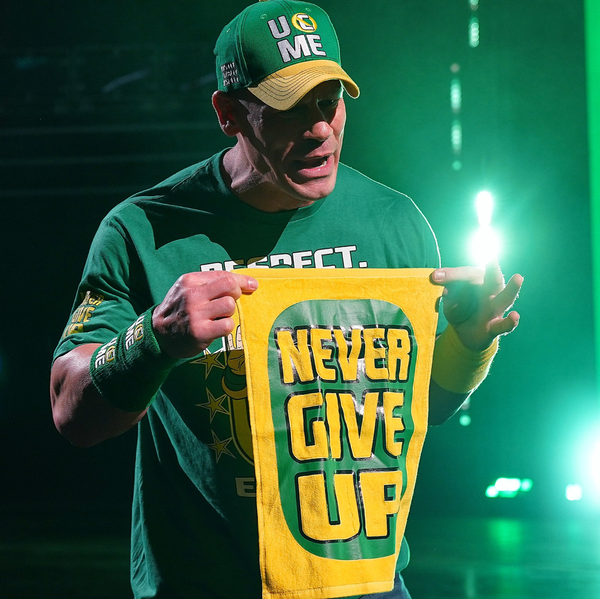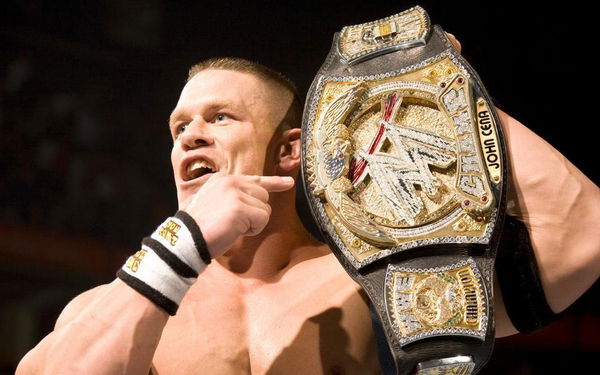

John Cena today is one of the most recognized stars to come out of WWE in the last 20 years. His rise to stardom as a pro wrestler made him a massive pop culture name and his popularity transcended the squared circle.
Watch What’s Trending Now!
Cena spent most of his career in WWE as a main-event star. He was the near-perfect poster boy that the company was looking for after some of its biggest stars had left.
WWE presented him as the all-conquering, inspiring baby face that could do no wrong and Cena played that role to perfection. Over the years, the boy from Boston became a global brand.
ADVERTISEMENT
Article continues below this ad
ADVERTISEMENT
Article continues below this ad
Fans have known Cena as a WWE guy through and through and have seen him in his pro wrestling avatar for most of his life. But even before he was the Face That Ran the Place, or even way before he had his own TV series, Cena had another love and that was the love of bodybuilding.
The Franchise Player had one of the most impressive physiques in WWE and pulled off incredible feats of strength during his run.
All that fit neatly when you consider that Cena was a competitive bodybuilder from a young age. The 16-time WWE world champion actually wanted to be a bodybuilder before he found his true calling.
ADVERTISEMENT
Article continues below this ad
John Cena’s stint as a bodybuilder
John Cena had a passion for bodybuilding, which he wanted to pursue early in his life. Cena achieved a degree in exercise science and kinesiology. As an aspiring bodybuilder, he began his journey at the “mecca of bodybuilding” in Venice, California, in 1998.
Cena was around 21 years at his time and even though he wasn’t financially blessed, he was determined to make a name for himself in the sport. He began training at Gold’s Gym in California, home to many IFBB pro bodybuilders.

After some time, he decided to give competitive bodybuilding a shot. He participated in the 1999 NPC Ironman Magazine Naturally contest in Los Angeles. Cena came second in the contest. Given he was in his early 20s, his bodybuilding career looked promising.
For someone quite young, Cena boasted impressive muscular features, but as it turns out bodybuilding without being at the top was an expensive venture.
The future Hollywood star had to do odd jobs to pay his bills and make ends meet. This included him serving as a limousine rider for a while.
However, he had to cut the journey short. Despite his best efforts, he was falling short and needed something else.
He wasn’t bogged down by the disappointment of his bodybuilding journey and embodied the never give up attitude that later became a big part of his on-screen character.
A friend suggested Cena give pro wrestling a try, to which he agreed. He signed with the local Ultimate Pro Wrestling promotion in 1999 and kick-started a journey that would last another two decades.
Even there, Cena had humble beginnings and took some difficult routes before WWE came calling.
From wrestling in flea markets to headlining WrestleMania
For a long time, there has been a notion that Cena has always been a WWE guy and they handpicked him to be the face of the company. Some fans also complain that, like many other stars, Cena didn’t cut his teeth on the independent wrestling scene. However, that is off the mark.
After he left the field of competitive bodybuilding, he joined Ultimate Pro Wrestling, an independent promotion.
It was here that the man who would headline WrestleMania after WrestleMania in the future wrestled in flea markets and outdoor barbecues in front of a very little audience. Again, not to be deterred, Cena continued to hustle until he got a chance to dance with the big boys.

Cena signed with WWE’s developmental Ohia Valley Wrestling (OVW) in 2001. He wrestled under the ring name The Prototype, where he acted as a half-robot, half-human character.
A year later, he made his main roster debut on SmackDown. He marched to the ring and answered an open challenge from WWE legend Kurt Angle.
Despite competing against some established stars regularly, Cena wasn’t able to connect with the audience and his career appeared in jeopardy. In fact, he was told that he would be released in the next series of cuts.
But as luck would have it, Stephanie McMahon overheard Cena rapping while all the wrestlers were traveling on the same bus. She asked him to try it out on TV and the Doctor of Thuganomics was born!
The Franchise Player John Cena
As the gimmick went ahead, rapper Cena would rhyme insulting remarks to his opponents and show his ability on the mic. A heel run was then followed by babyface, but the rapping gimmick stayed.
During this time, Cena had many memorable feuds and matches and the company saw him as a top star. At WrestleMania 21, he defeated John Bradshaw Layfield to win his first WWE Championship.
A move to the flagship show Monday Night RAW followed. The rapper gimmick was dumped and in came The Franchise Player.

With WWE reeling from the departures of The Rock and Brock Lesnar, Cena took on the mantle of the company’s poster boy and carried it for over a decade. His impact and longevity in the WWE make him a candidate for the greatest WWE star of all time.
Cena became popular as the Never Give Up, fighting against the odds wrestler, and was soon a household name. Legendary matches with the likes of Shawn Michaels, Triple H, Randy Orton, Edge, and others followed.
He main-evented multiple WrestleMania events and was clearly the biggest star of his era.
Now that he has transitioned into Hollywood, he has found success there as well. But his WWE legacy will always endure. And yet it could’ve been all so different had he decided to continue his career in bodybuilding.
Watch This Story: 8 gym rules endorsed by WWE legend John Cena
ADVERTISEMENT
ADVERTISEMENT
ADVERTISEMENT
ADVERTISEMENT


